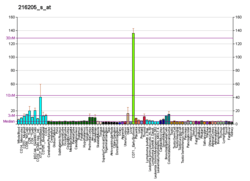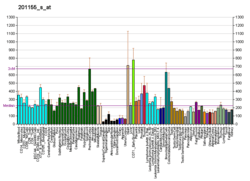MFN2
Mitofusin-2 is a protein that in humans is encoded by the MFN2 gene.[5][6] Mitofusins are GTPases embedded in the outer membrane of the mitochondria. In mammals MFN1 and MFN2 are essential for mitochondrial fusion.[7] In addition to the mitofusins, OPA1 regulates inner mitochondrial membrane fusion, and DRP1 is responsible for mitochondrial fission.[8]
Function
Mitofusin-2 is a mitochondrial membrane protein that participates in mitochondrial fusion and contributes to the maintenance and operation of the mitochondrial network.[9] Mitochondria function as a dynamic network constantly undergoing fusion and fission. The balance between fusion and fission is important in maintaining the integrity of the mitochondria and facilitates the mixing of the membranes and the exchange of DNA between mitochondria. MFN1 and MFN2 mediate outer membrane fusion while OPA1 is involved in inner membrane fusion.[10]
Mitochondrial fusion is essential for embryonic development. Knockout mice for either MFN1 or MFN2 have fusion deficits and die midgestation. MFN2 knockout mice die at embryonic day 11.5 due to a defect in the giant cell layer of the placenta.[7]
Fusion is also important for mitochondrial transport and localization in neuronal processes.[11] Conditional MFN2 knockout mice show degeneration in the Purkinje cells of the cerebellum, as well as improperly localized mitochondria in the dendrites.[12] MFN2 also associates with the MIRO-Milton complex which links the mitochondria to the kinesin motor.[11]
Clinical significance
Mutations of the gene are implicated in Charcot-Marie-Tooth disease. Charcot-Marie-Tooth disease type 2A (CMT2A) is caused by mutations in the MFN2 gene. While the symptoms of CMT2A are variable they are characterized by a sometimes early onset, severe phenotype, and optic atrophy. Mutations in OPA1 also cause optic atrophy, which suggests a common role of mitochondrial fusion in neuronal dysfunction.[12] The exact mechanism of how mutations in MFN2 selectively cause the degeneration of long peripheral axons is not known. There is evidence suggesting that it could be due to defects in the axonal transport of mitochondria.[12]
The MFN2 protein may play a role in the pathophysiology of obesity.[13] Mitochondria arrest fusion by downregulating Mfn2 in obesity and diabetes, which leads to a fragmented mitochondrial network.[14] This fragmentation is obvious in the pancreatic beta-cells in the Islets of Langerhans and can inhibit mitochondrial quality control mechanisms such as mitophagy and autophagy - leading to a defect in insulin secretion and eventual beta-cell failure.[15] The expression of MFN2 in skeletal muscle is proportional to insulin sensitivity in this tissue,[16] and its expression is reduced in high-fat diet fed mice[17] and Zucker fatty rats.[16]
This protein is involved in the regulation of vascular smooth muscle cell proliferation.[9]
References
- GRCh38: Ensembl release 89: ENSG00000116688 - Ensembl, May 2017
- GRCm38: Ensembl release 89: ENSMUSG00000029020 - Ensembl, May 2017
- "Human PubMed Reference:". National Center for Biotechnology Information, U.S. National Library of Medicine.
- "Mouse PubMed Reference:". National Center for Biotechnology Information, U.S. National Library of Medicine.
- Karbowski M, Lee YJ, Gaume B, Jeong SY, Frank S, Nechushtan A, Santel A, Fuller M, Smith CL, Youle RJ (Dec 2002). "Spatial and temporal association of Bax with mitochondrial fission sites, Drp1, and Mfn2 during apoptosis". J Cell Biol. 159 (6): 931–8. doi:10.1083/jcb.200209124. PMC 2173996. PMID 12499352.
- Santel A, Fuller MT (Feb 2001). "Control of mitochondrial morphology by a human mitofusin". J Cell Sci. 114 (Pt 5): 867–74. PMID 11181170.
- Chan DC (June 2006). "Mitochondria: dynamic organelles in disease, aging, and development". Cell. 125 (7): 1241–52. doi:10.1016/j.cell.2006.06.010. PMID 16814712.
- Liesa, Marc; Shirihai, Orian S. (2013). "Mitochondrial Dynamics in the Regulation of Nutrient Utilization and Energy Expenditure". Cell Metabolism. 17 (4): 491–506. doi:10.1016/j.cmet.2013.03.002. PMC 5967396. PMID 23562075.
- "Entrez Gene: MFN2 mitofusin 2".
- Chan DC (November 2006). "Dissecting mitochondrial fusion". Dev. Cell. 11 (5): 592–4. doi:10.1016/j.devcel.2006.10.009. PMID 17084350.
- Sheng ZH, Cai Q (February 2012). "Mitochondrial transport in neurons: impact on synaptic homeostasis and neurodegeneration". Nat. Rev. Neurosci. 13 (2): 77–93. doi:10.1038/nrn3156. PMC 4962561. PMID 22218207.
- Cartoni R, Martinou JC (August 2009). "Role of mitofusin 2 mutations in the physiopathology of Charcot-Marie-Tooth disease type 2A". Exp. Neurol. 218 (2): 268–73. doi:10.1016/j.expneurol.2009.05.003. PMID 19427854.
- Zorzano A, Sebastián D, Segalés J, Palacín M (September 2009). "The molecular machinery of mitochondrial fusion and fission: An opportunity for drug discovery?". Curr Opin Drug Discov Dev. 12 (5): 597–606. PMID 19736619.
- Liesa, Marc; Shirihai, Orian S. (2013). "Mitochondrial Dynamics in the Regulation of Nutrient Utilization and Energy Expenditure". Cell Metabolism. 17 (4): 491–506. doi:10.1016/j.cmet.2013.03.002. PMC 5967396. PMID 23562075.
- Trudeau, Kyle M.; Colby, Aaron H.; Zeng, Jialiu; Las, Guy; Feng, Jiazuo H.; Grinstaff, Mark W.; Shirihai, Orian S. (2016-07-04). "Lysosome acidification by photoactivated nanoparticles restores autophagy under lipotoxicity". J Cell Biol. 214 (1): 25–34. doi:10.1083/jcb.201511042. ISSN 0021-9525. PMC 4932370. PMID 27377248.
- Bach, Daniel; Pich, Sara; Soriano, Francesc X.; Vega, Nathalie; Baumgartner, Bernhard; Oriola, Josep; Daugaard, Jens R.; Lloberas, Jorge; Camps, Marta (2003-05-09). "Mitofusin-2 Determines Mitochondrial Network Architecture and Mitochondrial Metabolism A NOVEL REGULATORY MECHANISM ALTERED IN OBESITY". Journal of Biological Chemistry. 278 (19): 17190–17197. doi:10.1074/jbc.M212754200. ISSN 0021-9258. PMID 12598526.
- Sorianello, Eleonora; Soriano, Francesc X.; Fernández-Pascual, Sergio; Sancho, Ana; Naon, Deborah; Vila-Caballer, Marian; González-Navarro, Herminia; Portugal, José; Andrés, Vicente (2012-04-01). "The promoter activity of human Mfn2 depends on Sp1 in vascular smooth muscle cells". Cardiovascular Research. 94 (1): 38–47. doi:10.1093/cvr/cvs006. ISSN 0008-6363. PMID 22253285.
Further reading
- Zorzano A, Bach D, Pich S, Palacín M (2004). "[Role of novel mitochondrial proteins in energy balance]". Revista de medicina de la Universidad de Navarra. 48 (2): 30–5. PMID 15382611.
- Pawlikowska P, Orzechowski A (2007). "[Role of transmembrane GTPases in mitochondrial morphology and activity]". Postepy Biochem. 53 (1): 53–9. PMID 17718388.
External links
- GeneReviews/NCBI/NIH/UW entry on Charcot-Marie-Tooth Neuropathy Type 2
- Overview of all the structural information available in the PDB for UniProt: O95140 (Mitofusin-2) at the PDBe-KB.





